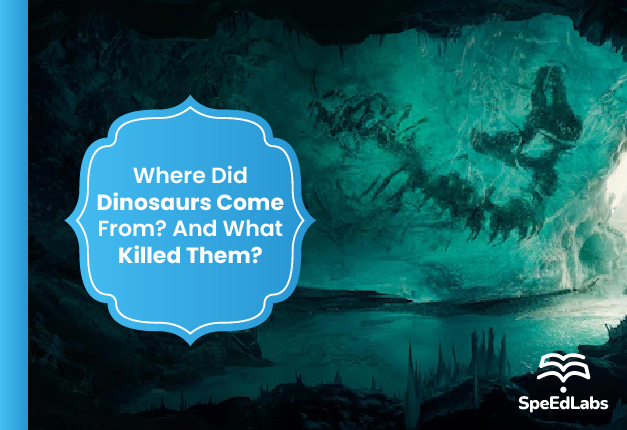Dinosaurs were a successful group of animals that appeared between 240 million and 230 million years ago and ruled the world until about 66 million years ago when a massive asteroid collided with Earth. Dinosaurs evolved from a group of mostly dog- and horse-sized creatures to the most massive beasts that ever existed on land during this period.
Origin and Evolution of Dinosaurs
Dinosaurs evolved from other reptiles (socket-toothed archosaurs) over 230 million years ago during the Triassic period. Dinosaurs evolved shortly after the Permian extinction, the largest mass extinction ever recorded on Earth. Mammals evolved during this period (the Triassic period).
The First Dinosaurs: The first dinosaurs were small and light, measuring mostly 10-15 feet long (3 to 4.5 m). They were probably agile and fast bipedal carnivores or omnivores.
Madagascar, an island off the coast of SE Africa, has been home to the world’s oldest-known dinosaurs. These dinosaur fossils were discovered approximately 230 million years ago during the Triassic period.
Eoraptor Lunensis (meaning “dawn raptor”) was the earliest-known dinosaur until recently. It lived around 228 million years ago. It was a small, primitive theropod (a bipedal meat-eater) about three feet (one metre) long. It once lived in Argentina, South America (fossils were found at the Ischigualasto Formation).
Dinosaurs rose to dominance during the Jurassic period (201.3 million to 145 million years ago), and some grew to enormous proportions.
As the continents moved apart during the Cretaceous period, dinosaur dominance persisted. T. rex, Triceratops, Spinosaurus, and Velociraptor are examples of famous dinosaurs from this period. The largest dinosaurs known to science, including Argentinosaurus, lived during the Cretaceous period. The Cretaceous-Tertiary (K-Pg) extinction event occurred when a 6-mile-wide (10-kilometre) asteroid collided with Earth, leaving an impact crater more than 110 miles (180 km) in diameter in what is now Mexico’s Yucatan Peninsula.
What wiped out the Dinosaurs?
Scientists have been attempting to solve a million-year-old mystery. Researchers believe they have finally solved the case.
Evidence discovered in a rock layer in the 1980s led many scientists to believe that an asteroid caused the extinction event.
Others thought it was caused by volcanic activity.
The apocalyptic idea of a global winter caused by a meteor impact or volcano eruption killing the giant reptiles became romanticised in people’s minds. However, scientists were having difficulty locating the “smoking gun.”
How was the mystery solved?
A discovery, according to a press release from the University of Texas, aided in the search.
The Chicxulub impact crater was discovered beneath the Gulf of Mexico in the 1990s and was “the same age as the rock layer.”
An asteroid collided with Earth 66 million years ago, causing a crater half on land and half underwater on the Yucatan Peninsula.
Two meteors will pass by Earth, one named after Apophis, the God of Chaos.
According to the researchers, the new study “essentially seals the dinosaur’s fate by finding asteroid dust with a matching chemical fingerprint within that crater at the precise geological location that marks the time of the extinction.”
An asteroid killed dinosaurs.
“The circle has been closed,” says Steven Goderis, a geochemistry professor at Vrije Universiteit Brussel.
Proof and Evidence of the Asteroid Impact Hypothesis
CRATER IMPACT
This 150-kilometre-wide crater is located just off the coast of the Yucatan Peninsula. It was blasted into Earth by a 10-kilometre-wide asteroid or comet travelling at 30 kilometres per second – 150 times faster than a jet airliner.
Scientists believe the impact that formed this crater occurred 65 million years ago. The date corresponds exactly to the extinction of dinosaurs.
METAL THAT IS RARE
Iridium, a metal similar to platinum, is extremely rare on Earth’s surface but abundant in asteroids and molten rock deep within the planet.
Scientists discovered iridium levels 30 times higher than average in the Cretaceous/Tertiary (KT) boundary, a layer of sedimentary rock laid down during the dinosaur extinction.
MELTED ROCK
These molten rock fragments, known as impact ejecta, are evidence of an explosion powerful enough to instantly melt bedrock and propel it more than a hundred miles away from its source.
Impact ejecta, which can range in size from large chunks to tiny beads, are common at or near the Cretaceous/Tertiary (KT) boundary, the geological layer that defined the dinosaur extinction.
FRACTURED CRYSTALS
These crystals, also known as “shocked quartz,” have a distinct fracturing pattern caused by high-energy impacts or explosions.
According to some scientists, the fracture pattern in these quartz crystals could have only been caused by a massive asteroid or comet impact. The pattern is common in quartz found near or at the Cretaceous/Tertiary (KT) boundary, the geological layer formed during the extinction.
FOSSIL RECORD
A gradual decline in the number of dinosaur species would most likely reflect a similarly gradual cause of their eventual extinction. A sudden “now you see them, now you don’t” end to the dinosaurs, on the other hand, implies a catastrophic cause. The fossil record appears to say different things depending on location and interpretation.
Some paleontologists believe that dinosaurs were doing well before the end of the Cretaceous period and were not declining in abundance when the impact occurred.
Also published on Medium.
